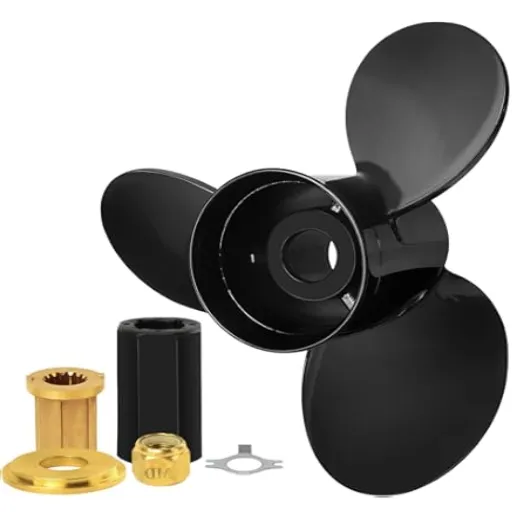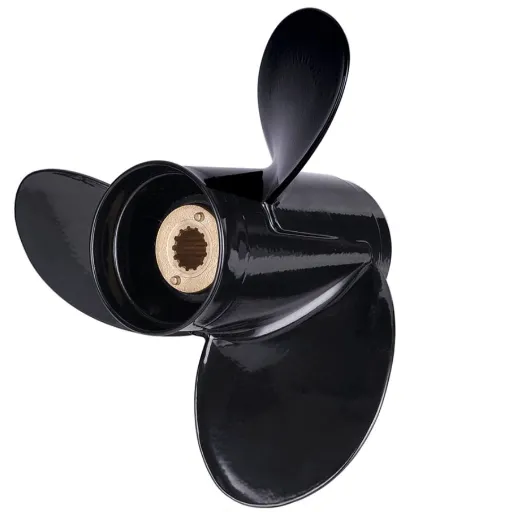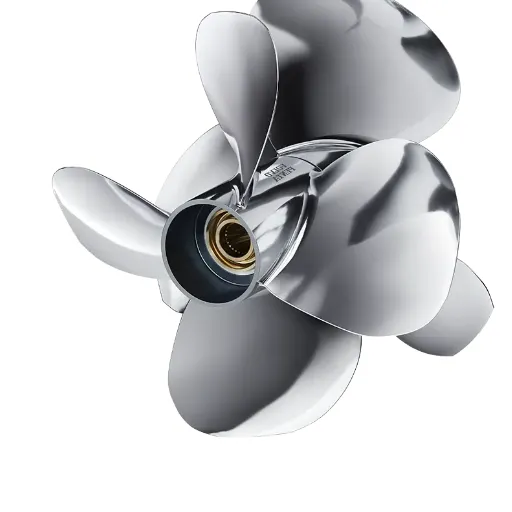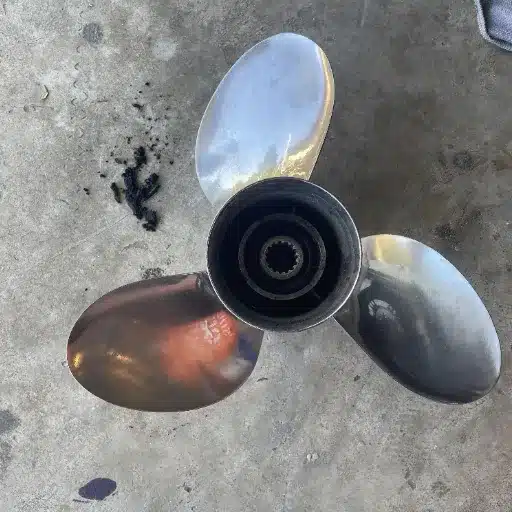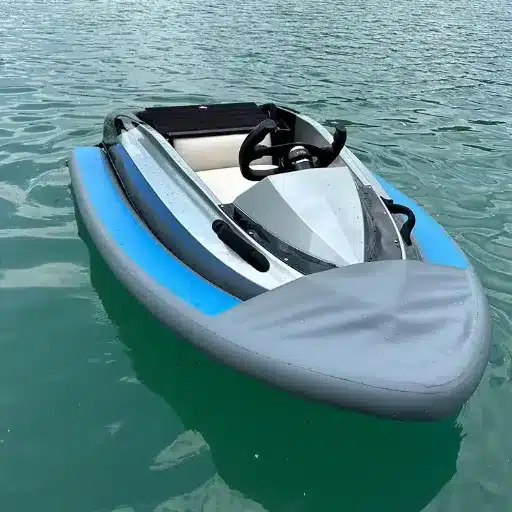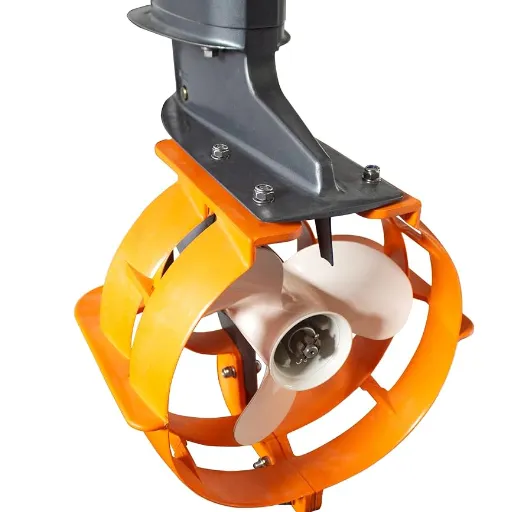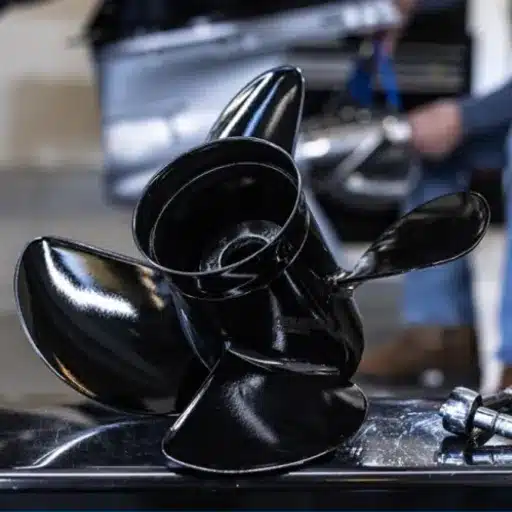When it comes to enhancing the performance of your 1150 Outboard Mercury boat motor, a perfect propeller assembly can do the rest. The propeller is not just a spinning contraption: it maximizes your boat’s speed, fuel consumption, and handling. With an evolving technology landscape and options changing by 2025, a perfect fit of a propeller might seem confusing. This guide is designed to explain the entire procedure, walk you through essential considerations, provide expert advice, and cover all the factors that tie the selected propeller to a better boating experience. Whether your goal is to maximize speed, fuel economy, or durability, this article will provide the information you need to make an informed choice. Let us be together as we unpack all you need to know to get your vessel working at full capacity!
Understanding the Mercury 1150 Outboard Motor
Mercury Marine Model 1150: General Description
The Mercury Marine Model 1150 has stood for innovation in Mercury’s famous line of outboard motors, celebrated for its reliability and robust performance. The late 1960s saw the model’s launch, with its 6-cylinder 2-stroke configuration producing approximately 115 horsepower, making it popular for both recreational and professional boating. The specifications were designed to achieve a greater power-to-weight ratio, along with smooth acceleration and speed characteristics. However, it was not intended to compromise on fuel efficiency.
The engine burns fuel through direct injection, a modern engineering method that minimizes emissions while maximizing overall performance. With an all-throttle rated range between 5100 and 5750, the Model 1150 serves a rather versatile solution for almost any boating activity from fishing boats to high-speed cruisers. Another feature contributing to its name in ships is the reputation of being sturdy and easy to maintain. The Mercury 1150 remains a strong option, whether you want to upgrade your boat or simply guarantee reliable power while out on the water.
Specifications and Features of the 1150
Configured with six inline cylinders, this 115-hp outboard powerfully meets the needs of various boating applications. Engined at 99.8 cu. In (1.63 liters), it delivers heavy torque and smooth acceleration, depending on whether you’re cruising leisurely or demanding.
| Specification | Details |
|---|---|
| Configuration | 6-cylinder, 2-stroke inline |
| Horsepower | 115 HP |
| Displacement | 99.8 cu. in (1.63 liters) |
| Weight | Approximately 298 pounds |
| RPM Range | 5100-5750 RPM |
| Gear Ratio | 2.00:1 |
| Fuel System | Dual carburetors with direct injection |
| Start Options | Manual and electric start available |
The 1150 is equipped with dual carburetors, ensuring that fuel is delivered efficiently and providing quick starts, while minimizing downtime and maximizing fuel economy. The advanced cooling system helps maintain operational temperatures for consistent performance, even during extended periods under harsh conditions. Lightweight, the engine weighs just about 298 pounds, so it doesn’t stress out boats, thus enhancing their efficiency and handling.
The 1150 comes with both a manual start option and an electric start option, allowing users to choose the option that suits their preference and convenience. It features an increased gear ratio of 2.00:1, providing a smooth and controlled power transfer in various water conditions. Corrosion-resistant finishes further contribute to the product’s durability, while providing maintenance access points that render servicing a breeze, thereby making it a rewarding option for both recreational and professional boaters.
The mounting design of the Mercury 1150 offers excellent versatility, allowing for installation on a wide range of hull types, from fishing boats to sport cruisers. It is this amalgamation of power, reliability, and ease of use that makes these outboards stand apart in marine performance.
Importance of Choosing the Right Propeller
Classifying the right propeller is crucial for a boat’s performance, fuel efficiency, and overall handling. Having the correct propeller allows your engine to stay within the recommended RPM range, so it can ideally exert power, neither straining the motor nor failing to utilize it fully. For example, blade design, size, and material all influence acceleration, top speed, and fuel consumption rates. Aluminum propellers are inexpensive and lightweight, while steel propellers can withstand more stress and are considered to perform better under high stress. Additionally, pitch and diameter should not be overlooked; a low pitch allows for outstanding acceleration, while a high pitch affords a good top speed. Being specific in choosing a propeller based on one’s boating skills for watersports, cruising, or fishing is a step toward achieving smooth and responsive performance.
Types of Propellers for the Mercury 1150
Aluminum vs. Stainless Steel Propellers
Knowing the advantages of each type would give you an informed choice between aluminum and steel propellers for the 1150 Mercury. Aluminum propellers are widely chosen because of their lower construction costs and lighter weight. They suit casual boaters who use vessels for recreation and therefore do not engage in high-performance activities, such as racing. Aluminum propellers possess some flexibility in construction, which minimizes damage from hard contact with underwater debris.
Aluminum Propellers
- Lower construction costs
- Lightweight design
- Ideal for recreational boating
- Flexible construction reduces damage
- Easy to repair minor damage
- Good for casual use
Stainless Steel Propellers
- Superior performance and durability
- Excellent corrosion resistance
- Rigid structure maintains blade shape
- Greater acceleration and speed
- Ideal for high-performance activities
- Premium cost but long-lasting
Conversely, stainless steel propellers confer better performance and durability. They stand greater wear and, therefore, have excellent resistance to corrosion under strong marine conditions due to their rigid structure. With this, the propeller can retain its blade shape under pressure, thereby offering greater acceleration and speed. Due to the premium cost of stainless steel propellers, they are always a worthwhile purchase for those who engage in high-speed activities or have heavy-duty applications in watersports or offshore ventures.
To sum up, the choice between aluminum and steel should be based on your performance needs, the environment, and your budget. Examining these three options will ensure you get the utmost value out of your Mercury 1150 prop, both in terms of performance and longevity, thereby enhancing your overall boating experience.
3-Blade vs. 4-Blade Propellers Options
When it comes to choosing between a 3-blade and a 4-blade propeller, it is essential to understand the differences and how they impact performance. The 3-blade propeller is the most used and has excellent top-end speed and fuel efficiency. It creates minimal drag in the water, making it ideal for all general-purpose boating activities, including cruising and light watersports. Due to its high-speed efficiency, this design is commonly the preferred choice for most standard applications.
| Feature | 3-Blade Propeller | 4-Blade Propeller |
|---|---|---|
| Top Speed | Excellent | Good (slightly reduced) |
| Acceleration | Good | Superior (hole-shot) |
| Fuel Efficiency | Excellent | Good |
| Low-Speed Control | Standard | Superior |
| Rough Water Performance | Good | Excellent |
| Vibration | Moderate | Reduced |
| Best Application | Cruising, general boating | Towing, rough water, precision |
In contrast, the 4-blade propeller takes into consideration stability, quicker acceleration, and better control at low speeds. This extra blade increases surface area, enhancing its grip on the water; such a feature is especially desirable in situations where precision is required, for example, towing water skiers or navigating through rough water. The top speed is marginally compromised with this design, while mid-range efficiency and superior handling are gained in return.
According to the theory behind it, a much heavier load under operation would make 4-blade propellers more useful in either rough or choppy waters for thrust and reliability. Testing has shown that a 4-blade configuration, in any case, gives you better hole-shot performance than cavitation, so it is generally suggested for more demanding rounds. Depending on what matters most for your performance and boat activities, you can choose the one that fits onto your engine. For a Mercury 1150 setup, these considerations will guide you in choosing between speed and stability.
Getting to Know the 15 Spline Setup
The 15-spline configuration is a vital feature that ensures compatibility and effective power transfer between the propeller and engine shaft in marine setups. The design of the spline enhances torque delivery by allowing for a near-perfect fit, which limits the possibility of slipping, especially in higher horsepower or heavier load conditions. Primarily used in mid-range and high-range outboard engines, this system is capable of withstanding large amounts of force and producing consistent operation on the other side.
15-Spline System Benefits:
- Enhanced Torque Delivery: Near-perfect fit minimizes power loss
- Broad Compatibility: Works with various propeller options
- Customization Options: Allows optimization for speed, stability, or fuel economy
- Simplified Maintenance: Easy replacement and servicing
- Corrosion Resistance: Typically made from stainless steel
One of the advantages of the 15-spline configuration is that it allows for a broader range of propeller options to be installed on the system. This means that boaters can further customize their systems for speed, stability, or fuel economy with options featuring three or four blades. Moreover, for some users with Mercury 1150 engines, the 15-spline system simplifies compatibility while easing maintenance and replacement.
With the durability factor in mind, most 15-spline systems are made of corrosion-resistant materials, such as stainless steel, so that they can last even in very harsh saltwater conditions. If performance and reliability are on your list of priorities, the 15-spline configuration provides a robust solution for meeting the requirements of both recreational and professional boating activities.
Factors to Consider When Selecting Propeller Assembly
Performance Needs Based on Boat Type
When selecting a propeller assembly, it is crucial to consider the performance requirements of the specific boat type. For example, larger crafts such as yachts or cruisers might opt for propellers that offer greater thrust and fuel efficiency, ensuring their performance is good during cruising over long distances. Speedboats and watercraft used for racing or recreation are designed for speed and require high-pitch propellers with reduced drag for improved acceleration.
Propeller Requirements by Boat Type:
- Fishing Boats: Lower-pitch propellers for constant power at low speeds and heavy load carrying
- Speedboats/Racing: High-pitch propellers with reduced drag for maximum acceleration
- Cruisers/Yachts: Balanced thrust and fuel efficiency for long-distance travel
- Commercial Vessels: Durable materials prioritizing output and longevity
- Watersports: Quick acceleration and responsive handling for towing activities
Fishing boats demand constant power at low speeds and hence ought to be fitted with lower-pitch propellers capable of carrying heavier loads and offering fine, low-speed steering in shallow-type areas. Commercial ships prioritize durability and output, as they often utilize materials that promise long-term use in harsh, demanding environmental conditions.
Each type of boat is associated with different and unique requirements for the kind of performance we expect from it. Thus, one must consider the compatibility of the engine, load capacity, and nature of operating conditions before making a choice. Catering to the needs of the propeller assembly according to these requirements enables the highest degree of functionality and efficiency on the water.
Factors Affecting the Compatibility of Engine Parts with Mercury Outboards
It is crucial to ensure engine part compatibility if one wishes the Mercury outboards to perform well and have a long life. Propellers, fuel filters, spark plugs, and water pump kits are some of the key components that must be compatible with your Mercury outboard model. Compatibility depends on factors such as engine horsepower, year of manufacture, and actual working conditions. Selecting the correct propeller pitch and diameter, for example, can result in improvements in speed, fuel efficiency, and a reduction in engine strain.
Key Compatibility Factors:
- Engine horsepower specifications
- Year of manufacture and model variations
- Operating conditions and environment
- Spline configuration (15-spline for Mercury 1150)
- Propeller pitch and diameter requirements
- Material compatibility with marine environment
Additionally, modern Mercury outboards incorporate advanced technologies such as electronically controlled fuel injection systems and digital controls, ensuring the exact matching of parts to achieve optimal functionality. This says it all: choosing OEM parts ensures a perfect fit and compatibility with Mercury engineering. Reliable parts ensure reliable engine performance, improved fuel economy, and lower exhaust emissions, resulting in a more enjoyable boating experience.
Propeller Technology Trends in 2025
Propeller technology is expected to experience progress in materials, design developments, and intelligent integration by 2025. The organisation views lightweight yet sturdy materials, such as carbon fibre composites, to enhance efficiency and reduce fuel demand. These materials serve by standing up to corrosion and allow for designs that emphasize thrust while minimizing drag.
2025 Technology Innovations:
- Carbon Fiber Composites: Lightweight, durable materials for enhanced efficiency
- Variable Pitch Propellers: Real-time blade pitch adjustment for optimal performance
- CFD Optimization: Computer modeling for maximum thrust-to-drag ratios
- Smart Sensors: Real-time monitoring of rotation speed and water pressure
- Bio-based Coatings: Environmentally friendly anti-fouling solutions
- Noise Reduction Design: Advanced blade geometries for quieter operation
Among the emerging trends is the variable pitch propeller designed for variable dynamic performance adjustment. Such propellers vary the blade pitch in real-time to improve responsiveness under changing water conditions and engine speeds. Additionally, CFD ensures that propeller shapes are modeled and tested for maximum optimization, allowing engineers to achieve previously unattainable performance benchmarks.
Another key area is the integration of smart sensors into modern propeller systems. They provide real-time information on rotation speed, water pressure, and cavitation to an onboard management controller. Based on the data analysis, the operator can optimize the vessel’s performance, monitor its effectiveness, and anticipate maintenance to prevent downtime.
The future of propeller technology is powerfully shaped by sustainability. Bio-based coatings and environmentally friendly designs are among the innovations that aim to mitigate adverse environmental effects, including reduced fuel consumption and noise pollution. Together, these advancements herald a new era of performance, sustainability, and intelligent design in the marine propulsion realm.
Installation and Maintenance of Propellers
Step-by-Step Guide to Propeller Installation
The proper installation of a propeller is critical in achieving maximum performance, safety, and longevity. Correct installation of your propeller can be carried out following the detailed guide:
Installation Steps:
- Prepare the Tools and Work Area: Gather all the necessary tools, such as a socket wrench, torque wrench, gloves, marine grease, and a new cotter pin, if needed. Ensure your working environment is entirely safe and stable, monitoring for any hazards that may introduce an element of risk, such as water or uneven flooring.
- Inspect the Propeller and Shaft: Before installation, inspect both the propeller and propeller shaft for any damage, cracks, corrosion, or pitting. Thoroughly clean the shaft to remove any debris and ensure it is free from rust and old lubricant.
- Apply Marine Grease: Apply a thin layer of grease to the propeller shaft. It should prevent corrosion, allow for smooth friction, and facilitate easy removal in the future. The grease should be applied evenly on the entire shaft surface.
- Position the Propeller on the Shaft: Align the propeller carefully with the shaft splines, then slide it into place. With any pressure to fall, do not exert any on the propeller or shaft to rim/crack either of them. Ensure the propeller is well seated with no wobble.
- Install the Washer and Nut: Place the thrust washer on the shaft and then thread on the propeller nut to secure the propeller. The tightening sequence and torque specifications required for your propeller model should be found in the manufacturer’s instructions.
- Torque the Nut to Specification: Using a torque wrench, torque the propeller nut to the specification recommended by the propeller or engine manufacturer. Overtightening will strip threads, and under-tightening will cause potential failure during operation.
- Install the Cotter Pin or Locking Mechanism: Secure the nut in place by applying a cotter pin or using the locking mechanism provided by the manufacturer. This extra layer of safety prevents the nut from vibrating loose during engine operations. Always use new cotter pins, never old ones; this will contribute to reliability.
- Perform the Final Inspection: Once all components are installed, re-check to ensure that all components are properly seated and securely fastened. Spin the propeller by hand, checking that it turns freely and does not hit against any part of the boat or the shaft housing.
- Test the Installation: After the installation is complete, a water test should be performed to ensure proper operation. Adjust as needed, if unusual vibrations or sounds emerge, or performance deteriorates.
These steps will help ensure the safe, efficient, and reliable installation of the propeller. Regular maintenance and checks following the installation will serve to increase the propeller’s life and optimize overall performance.
Maintenance Tips for Longevity of Propeller Assembly
A well-maintained propeller assembly and longevity into the future depend on regular inspection and preventive maintenance. A few tips to keep the propeller in perfect condition are:
Essential Maintenance Practices:
- Regular Cleaning: Remove debris, barnacles, and marine growth with suitable cleaning solutions
- Damage Inspection: Check blades for wear, cracks, bends, or pitting during each use
- Shaft Alignment Check: Ensure proper alignment to prevent uneven wear
- Lubrication: Apply marine grease to shaft and fittings regularly
- Performance Monitoring: Watch for vibrations, speed reduction, or fuel consumption changes
- Winter Storage: Remove and store in dry location with protective coating
- Professional Inspection: Schedule regular marine technician evaluations
Regular Cleaning: Debris, barnacles, or other marine growth can diminish the efficiency and cause imbalances. Clean the propeller regularly with suitable cleaning solutions to remove buildup without worrying about scratching or damaging it.
Inspect for Damage: Frequently examine the blades for signs of wear, cracks, bends, or pitting. Minor damage can cause vibration, result in reduced performance, and lead to higher fuel consumption.
Check Propeller Shaft Alignment: A misalignment results in uneven wear on the propeller and the associated components. It is best to periodically test for proper alignment during regular maintenance to prevent damage over time.
Lubrication and Corrosion: Marine grease should be applied liberally to the propeller shaft and its fittings to create a smooth sliding surface and prevent corrosion. Inspect the condition of the sacrificial anodes and replace them as necessary to prevent galvanic corrosion.
Monitoring Performance: Try ruling out phenomena that reduce performance, such as abnormal vibrations caused by unnoticed problems with the propeller, speed diminution, and increased fuel consumption.
Storage over the Winter: If there is no need to use it, the propeller should be removed and stored in a dry, safe location, applying a protective coating of lubricant to prevent rust or damage during the winter layup.
Professional Inspection: Have a marine technician inspect your vessel from a different angle regularly to identify and address issues that may be less visible, ensuring continued performance and safety.
By following the maintenance procedures outlined, you can maximize the lifespan of your propeller assembly, improve efficiency, and prevent costly repairs or replacement.
Troubles Faced by Propellers and Their Remedies
Being crucial to a vessel’s performance, propellers are prone to several common issues. Keeping track of these issues and addressing them promptly can help your equipment function optimally and last longer. Here are some of the common problems and their solutions:
Cavitation
Problem: Air bubbles form around propeller blades due to sudden pressure drop, causing vibrations and noise that can erode blade surfaces.
Solution: Ensure well-designed blade, proper engine alignment, and select appropriate propeller size and type for hull and operating conditions. Conduct periodic inspections for early cavitation pitting.
Physical Damage
Problem: Dents, chips, and cracks in blades from impacts with underwater debris, causing efficiency loss and vibrations.
Solution: Visual inspection after suspected impacts. Repair minor damage immediately to prevent worsening. Severe damage may require professional repair or replacement.
Corrosion
Problem: Corrosion weakens propeller material, especially in saltwater environments.
Solution: Use corrosion-resistant metals like stainless steel or bronze. Apply protective coatings regularly and install sacrificial anodes to prevent galvanic corrosion.
Unbalanced Propeller
Problem: Imbalance due to wear or damage causes severe vibrations that can harm engine or drivetrain.
Solution: Regular testing and balancing by experts. Use digital balancing techniques for precise tuning.
Marine Growth
Problem: Algae, barnacles, or other marine organisms accumulate on propeller surface, creating drag and reducing efficiency.
Solution: Apply antifouling coatings and clean propeller periodically. Consider specialized underwater cleaning services for thorough maintenance.
Wrong Propeller Size or Pitch
Problem: Incorrect size or pitch results in poor performance, reduced speed, and excessive fuel consumption.
Solution: Study propeller-sizing charts and consult manufacturer recommendations for your specific engine model and hull type.
Shaft Misalignment
Problem: Misaligned propeller shaft causes uneven wear and inefficiency.
Solution: Check alignment regularly and use high-quality hardware for installation. Advanced tools enable more precise and efficient alignment.
Identifying these common issues and establishing a routine maintenance schedule will help keep your vessel from requiring heavy repairs and allow it to perform well, ensuring it can be used safely.
Case Studies and Data Analysis
Comparative Data Among Various Propeller Types
Analyzing the different types of propellers reveals that they can have varying levels of performance in terms of design, efficiency, and application. Fixed-pitch propellers are the most commonly used because of their simplicity and reliability. They perform very well under steady operating conditions and require less maintenance. However, they are the least flexible of all, and their efficiency varies with changes in speed or load, which ultimately affects fuel economy.
| Propeller Type | Complexity | Maintenance | Efficiency | Cost | Best Application |
|---|---|---|---|---|---|
| Fixed-Pitch | Low | Minimal | Variable | Low | Steady operating conditions |
| Controllable-Pitch | High | Extensive | Optimal | High | Variable conditions, ferries |
| Specialized | Medium | Moderate | Targeted | High | Tugboats, offshore platforms |
By contrast, controllable-pitch propellers boast several significant advantages whenever they are used under varying conditions. They pitch the blades according to the demand of the load to ensure that solutions are optimal for achieving fuel efficiency and maneuverability. Such propellers are ideally suited for vessels that frequently change speed or direction, such as ferries or fishing vessels. However, with such complexity usually comes a steep price for acquisition and ongoing maintenance, which in turn should be considered when preparing the operational plan for such a vessel.
Finally, some special types provide the much-needed thrust for tugboats or offshore platforms that require precise maneuverability. Providing the choice is seldom used due to its narrow application, yet the operational advantages offered by such propellers can give specialized industries a competitive edge. The final decision regarding the type of propeller chosen depends on the vessel’s stipulated use, the operating environment, and the pros and cons of cost; therefore, it is based on an assessment of both immediate and future needs.
Effect of Propeller Selection on Fuel Efficiency
Whenever you want to talk about fuel consumption, the first topic of concern is propellers. On the contrary, I have learned this by observing many qualities. Proper matching of a propeller enables it to maximize the conversion of available energy, allowing the vessel to move through water with minimal resistance. Hence, a correctly sized propeller with good pitch and blade design would reduce the engine load, thus increasing efficiency and decreasing fuel consumption. Apart from reducing operational costs, this would also support sustainability in another way: less fuel consumption means fewer emissions.
Fuel Efficiency Optimization Factors:
- Proper Propeller Matching: Maximizes energy conversion and minimizes water resistance
- Correct Pitch and Blade Design: Reduces engine load and increases efficiency
- Operating Conditions: Speed, vessel type, and load considerations
- Real-time Adjustability: Variable-pitch propellers for changing conditions
- CFD Analysis: Data-driven insights for optimal design selection
- Environmental Benefits: Lower fuel consumption reduces emissions
Having said that, operating conditions cannot be underplayed while selecting props. Speed, vessel type, and the intended load typically play a crucial role in choosing the propeller. Considered to work at fixed speeds, a fixed-pitch propeller might be preferred; however, an adjustable-pitch propeller may be more suitable for working under changing conditions and to provide smooth operation, as demanded in real-time operation. Having the right one is crucial, as energy wasted is unsustainable, especially for ships that frequently change speeds or encounter varying water conditions.
I believe that collaboration with marine engineers or performing CFD analysis has always yielded better results. This provides data-driven insights to select designs optimized for their vessels undertaking the route. Proper emphasis on propeller selection leads to long-term savings, environmental initiatives, and, of course, significant improvements in operational performance.
Reference Sources
-
Parts for Mercury Marine 1150 Propellers – Marine Engine: Provides detailed information on propeller assemblies, including aluminum options and pitch specifications.
-
Mercury 115hp Propellers, Model 1150 15 Spline – Rubex Props: Offers Solas propeller charts with various blade options for Mercury 1150 models.
-
OEM 13 1/4 x17 Upgrade Boat Propeller – Amazon: Features specific propeller models compatible with Mercury 1150 engines, including pitch and size details.
-
Prop Help for My New 115 Mercury – The Hull Truth Forum: Discusses user experiences and recommendations for propeller sizes and materials.
-
How to Choose the Right Mercury Outboard Propeller – VIF Prop: A comprehensive guide to selecting the right propeller, considering compatibility and advancements in Mercury engine technology.
- Find more info now.
Frequently Asked Questions (FAQs)
Which considerations go into selecting a proper propeller for your Mercury outboard motor?
Multiple factors influence the decision to purchase a propeller for your Mercury outboard motor, including pitch and diameter, as well as the type of boating you intend to do. You want to select a propeller with an RPM range that matches the engine’s requirements for maximum performance at wide-open throttle. You can use the prop selector tool to find the right one for a 115 hp engine. Also consider whether you want a 3- or 4-blade propeller, depending on how quickly you want to reach speed or how much acceleration you desire. Boat weight and the type of activities are also factors to consider.
What importance does the spline tooth hold in the assembly of the propeller?
The spline tooth is essential for providing a proper fit between the propeller and the Mercury outboard motor. For the Mercury 1150, the standard 15-spline type will facilitate a tight fit and withstand the torque generated by the engine. Differences in the spline tooth count could lead to performance issues and, worse still, damage to the engine components. Therefore, the correct spline tooth and number must be sought for the outboard engine to have a long and efficient working life. Always refer to the service manual for detailed specifications.
Can I fit aftermarket propellers on my Mercury outboard engine?
Aftermarket propellers for use with a Mercury outboard engine are possible, provided they fit the specified spline and configuration. Many aftermarket propellers are engineered to perform equal to or in some cases, even superior to OEM parts. One must ensure that aftermarket parts match the Mercury 1150 model and comply with all specifications. Researching through user reviews and performance tests could make one feel more confident about the reliability of the aftermarket sets. Always verify the part number to ensure compatibility.
What advantages are provided by the stainless-steel propeller on a Mercury 1150?
Here are a few advantages of installing a stainless steel propeller on a Mercury 1150: the first being that of durability and performance. Stainless steel propellers will bend less and suffer less damage than aluminum ones, especially in rough conditions. They may also slightly enhance fuel efficiency and overall performance, thereby contributing to the enjoyment of boating. A stainless steel propeller generally also possesses a sleeker design, give or take, and thus can reduce drag that might otherwise impede some speed. However, being more expensive than aluminum ones, you should weigh your options carefully according to your budget and intended use.
What is the use of the hub kit in propeller assembly?
The hub kit plays a critical role in assembling the propeller to the Mercury outboard engine. It is the connecting element that attaches the propeller to the engine shaft, allowing for efficient power transfer while the engine is running. A well-installed hub kit helps reduce vibration and may improve the performance and lifespan of the propeller as a whole. When changing or upgrading your propeller, consider that the hub kit is suitable for both your engine and the prop design. Correct installation ensures safe and efficient operation.




